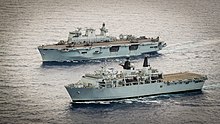Joint Expeditionary Force
The Joint Expeditionary Force (JEF) is a multinational expedition force and rapid reaction force that has existed since 2014 as a framework nation in Great Britain and is expected to mobilize over 10,000 soldiers. In addition to possible military operations within the framework of peace missions by the United Nations or the European Union (EU) and to deter potential opponents (including Russia after the Crimean crisis ), the use of humanitarian support is also part of the possible range of tasks.
history
The JEF was initiated by the British Chief of the Defense Staff (Chief of Defense Staff ) General David J. Richards in December 2012 and emerged from the British Joint Rapid Reaction Force (JRRF) founded in 1999 and operational in 2001 with the Spearhead Forces (spearhead forces ).
The JEF was agreed at the NATO summit on September 4, 2014 in Newport , Wales, and should be operational by the end of 2018.

In July 2016, the first military maneuver (Joint Venture 16) with around 1,600 British soldiers as part of the JEF took place on the RAF St Mawgan in Cornwall. The British amphibious assault ship HMS Ocean (L12) with the 42nd Marine Battalion (42 Commando) formed the marine component of the JEF from September 2016.
On June 30, 2017, at Karlberg Palace in Stockholm , the Swedish Defense Minister Peter Hultqvist and the Finnish Defense Minister Jussi Niinistö decided that the two Scandinavian nations would participate in the JEF.
In May 2018, a multinational major maneuver (Joint Warrior) of the Joint Expeditionary Force with around 12,000 soldiers from 17 nations took place on the Salisbury Plain in southern England. Involved were u. a. Parts of the British Parachute Regiment (PARA) , the Danish Jutland Dragoon Regiment ( Jydske Dragon Regiment ), the mechanized infantry brigade Geležinis Vilkas from Lithuania and the 1st (mechanized) infantry battalion from Latvia.
structure
The JEF consists of several components of the British armed forces British Army , Royal Air Force , Royal Navy and Royal Marines and was designed in such a way that other nations can also be involved with armed forces.
The naval component is also known as the Joint Expeditionary Force (Maritime) (JEF (M)) and consists of the former Response Force Task Group - Cougar Deployment.
The headquarters is the Standing Joint Force Headquarters (SJFHQ) and the commanding officer is a British major general . Major General Stuart Skeates is currently in command .
Member states
In addition to the United Kingdom as a framework nation, the Scandinavian NATO states Denmark , Norway , the Baltic NATO states Estonia , Latvia , Lithuania and the NATO member Netherlands as well as the two non-NATO states Finland and Sweden are participating.
See also
Individual evidence
- ↑ gov.uk: International partners sign Joint Expeditionary Force agreement , dated September 5, 2015, accessed September 2017.
- ↑ https://www.army-technology.com/uncategorised/newsuk-troops-train-joint-expeditionary-force-4965137/
- ↑ https://www.gov.uk/government/news/sweden-and-finland-join-uk-led-response-force
- ↑ https://www.gov.uk/government/news/uk-and-allies-stand-united-in-face-of-intensifying-threats
- ↑ https://www.royalnavy.mod.uk/news-and-latest-activity/operations/mediterranean-and-black-sea/joint-expeditionary-force-maritime